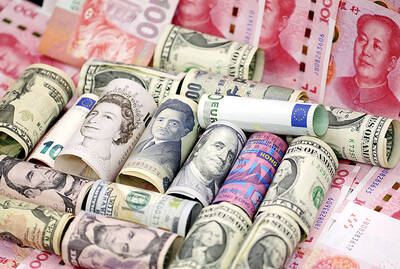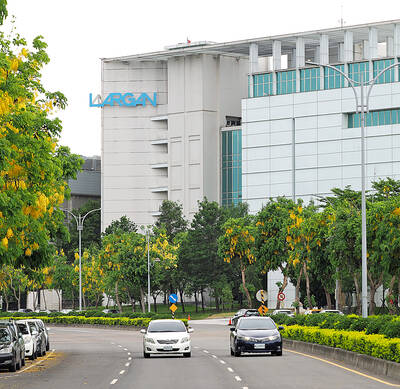Samsung Electronics Co’s chip foundry business is adding production capacity and more advanced manufacturing techniques, aiming to make gains on market leader Taiwan Semiconductor Manufacturing Co (TSMC, 台積電).
The South Korean company said that it would introduce 2-nanometer production for mobile phone parts by 2025 and expand applications.
Samsung would also significantly increase output in Pyeongtaek, South Korea, and Taylor, Texas, to shore up its foundry division, which makes chips for customers on a contract basis, the company said at a presentation on Tuesday in San Jose, California.

Photo: AFP
The world’s largest memorychip maker is looking to catch up with TSMC while also fending off a nascent challenge from Intel Corp, which is pushing into the foundry market.
While the chip industry in general is suffering from sluggish demand for mobile and personal computer parts, the artificial intelligence boom has spurred interest in advanced processors.
Samsung shared details of its 2-nanometer process technology, which would improve performance by 12 percent and power efficiency by 25 percent compared with its most advanced offering today, which is at 3 nanometers.
Like other chipmakers, Samsung is looking to geographically diversify its manufacturing footprint, which is heavily focused on East Asia.
The company, which has operated a facility in Austin for about 20 years, expects to complete the Taylor plant this year, aiming to commence operations in the second half of next year.
The expansion of production lines at Pyeongtaek along with the Taylor fab would boost Samsung’s capacity sevenfold by 2027 compared with 2021, the company said.
In addition to current chip manufacturing sites, Samsung plans to expand into a new Yongin production base.
US President Joe Biden’s administration is looking to cultivate domestic chip production with about US$50 billion in incentives. US officials have said they would give some of the funds to companies like Samsung and TSMC that are based overseas, but expanding on US soil.
Europe and Japan are also setting aside government money to foster the industry in those locations.
In the US, TSMC is building two fabs in Phoenix, Arizona, at which it is planning to make chips using its advanced 4-nanometer and 3-nanometer processes, with mass production scheduled to begin next year and in 2026 respectively.
The world’s largest contract chipmaker is also building a plant in Japan’s Kumamoto Prefecture, at which its 12-nanometer, 16-nanometer and 22-nanometer processes, as well as 28-nanometer specialty technology, would be used, with commercial production expected to start next year.
Meanwhile, a senior TSMC executive last month said that talks over a possible plant in Germany were continuing and that the earliest a decision would be made is in August.
Additional reporting by CNA and Reuters

Taiwan’s foreign exchange reserves hit a record high at the end of last month, surpassing the US$600 billion mark for the first time, the central bank said yesterday. Last month, the country’s foreign exchange reserves rose US$5.51 billion from a month earlier to reach US$602.94 billion due to an increase in returns from the central bank’s portfolio management, the movement of other foreign currencies in the portfolio against the US dollar and the bank’s efforts to smooth the volatility of the New Taiwan dollar. Department of Foreign Exchange Director-General Eugene Tsai (蔡炯民)said a rate cut cycle launched by the US Federal Reserve

Handset camera lens maker Largan Precision Co (大立光) on Sunday reported a 6.71 percent year-on-year decline in revenue for the third quarter, despite revenue last month hitting the highest level in 11 months. Third-quarter revenue was NT$17.68 billion (US$581.2 million), compared with NT$18.95 billion a year earlier, the company said in a statement. The figure was in line with Yuanta Securities Investment Consulting Co’s (元大投顧) forecast of NT$17.9 billion, but missed the market consensus estimate of NT$18.97 billion. The third-quarter revenue was a 51.44 percent increase from NT$11.67 billion in the second quarter, as the quarter is usually the peak

The US government on Wednesday sanctioned more than two dozen companies in China, Turkey and the United Arab Emirates, including offshoots of a US chip firm, accusing the businesses of providing illicit support to Iran’s military or proxies. The US Department of Commerce included two subsidiaries of US-based chip distributor Arrow Electronics Inc (艾睿電子) on its so-called entity list published on the federal register for facilitating purchases by Iran’s proxies of US tech. Arrow spokesman John Hourigan said that the subsidiaries have been operating in full compliance with US export control regulations and his company is discussing with the US Bureau of

Pegatron Corp (和碩), a key assembler of Apple Inc’s iPhones, on Thursday reported a 12.3 percent year-on-year decline in revenue for last quarter to NT$257.86 billion (US$8.44 billion), but it expects revenue to improve in the second half on traditional holiday demand. The fourth quarter is usually the peak season for its communications products, a company official said on condition of anonymity. As Apple released its new iPhone 17 series early last month, sales in the communications segment rose sequentially last month, the official said. Shipments to Apple have been stable and in line with earlier expectations, they said. Pegatron shipped 2.4 million notebook